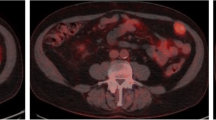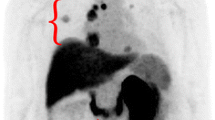Abstract
Purpose
Positron emission tomography (PET)/computed tomography (CT) with 68Ga-labelled 1,4,7,10-tetraazacyclododecane-N,N′,N″,N″‘-tetraacetic acid-d-Phe1-Tyr3-octreotide (DOTATOC) has been accepted as a diagnostic imaging tool especially for patients with neuroendocrine tumours. However, its clinical usefulness for restaging of renal cell carcinoma (RCC) has not been fully investigated. This retrospective study was performed to elucidate the clinical value of PET/CT using 68Ga-DOTATOC in patients with known or suspected recurrent RCC.
Methods
We analysed 25 consecutive patients who underwent DOTATOC-PET/CT scans after surgery for RCC (23 clear cell, 1 papillary, 1 unclassified). PET/CT findings were reviewed and the detection rate was calculated on a patient and lesion basis. The detectability was compared in patients who also underwent PET/CT scans with 18F-fluorodeoxyglucose (FDG). Histopathological findings or clinical follow-up were used as the reference standard.
Results
Based on the final diagnosis, 76 recurrent or metastatic lesions were confirmed in this population. Of these lesions, 66 lesions in 22 patients were positive by DOTATOC-PET/CT. The patient-based and lesion-based sensitivity was 88% (22/25) and 87% (66/76), respectively. Twelve patients underwent both DOTATOC-PET/CT and FDG-PET/CT. The lesion-based sensitivity of DOTATOC was 74% (20/27), while that of FDG was 59% (16/27). Eight lesions were identified only by DOTATOC, but four lesions from papillary RCC were detected only by FDG.
Conclusion
Our data indicate that DOTATOC-PET/CT would be useful for detecting recurrent foci in patients with clear cell RCC. DOTATOC-PET/CT and FDG-PET/CT are considered to have complementary roles.



Similar content being viewed by others
References
Rini BI, Campbell SC, Escudier B. Renal cell carcinoma. Lancet. 2009;373:1119–32.
Ljungberg B, Bensalah K, Canfield S, Dabestani S, Hofmann F, Hora M, et al. EAU guidelines on renal cell carcinoma: 2014 update. Eur Urol. 2015;67:913–24.
Bedke J, Gauler T, Grünwald V, Hegele A, Herrmann E, Hinz S, et al. Systemic therapy in metastatic renal cell carcinoma. World J Urol. 2017;35:179–88.
Volpe A, Bollito E, Bozzola C, Di Domenico A, Bertolo R, Zegna L, et al. Classification of histologic patterns of pseudocapsular invasion in organ-confined renal cell carcinoma. Clin Genitourin Cancer. 2016;14:69–75.
Ma H, Shen G, Liu B, Yang Y, Ren P, Kuang A. Diagnostic performance of 18F-FDG PET or PET/CT in restaging renal cell carcinoma: a systematic review and meta-analysis. Nucl Med Commun. 2017;38:156–63.
Reubi JC, Kvols L. Somatostatin receptors in human renal cell carcinomas. Cancer Res. 1992;52:6074–8.
Vikić-Topić S, Raisch KP, Kvols LK, Vuk-Pavlović S. Expression of somatostatin receptor subtypes in breast carcinoma, carcinoid tumor, and renal cell carcinoma. J Clin Endocrinol Metab. 1995;80:2974–9.
Kassabian A, Stein J, Jabbour N, Parsa K, Skinner D, Parekh D, et al. Renal cell carcinoma metastatic to the pancreas: a single-institution series and review of the literature. Urology. 2000;56:211–5.
Chan K, Luong TV, Navalkissoor S. 111In-DTPA-octreotide SPECT (OctreoScan) uptake in metastatic renal cell carcinoma to the pancreas. Clin Nucl Med. 2018;43:e29–30.
Barrio M, Czernin J, Fanti S, Ambrosini V, Binse I, Du L, et al. The impact of somatostatin receptor-directed PET/CT on the management of patients with neuroendocrine tumor: a systematic review and meta-analysis. J Nucl Med. 2017;58:756–61.
Graham MM, Gu X, Ginader T, Breheny P, Sunderland JJ. (68)Ga-DOTATOC imaging of neuroendocrine tumors: a systematic review and metaanalysis. J Nucl Med. 2017;58:1452–8.
Deppen SA, Blume J, Bobbey AJ, Shah C, Graham MM, Lee P, et al. 68Ga-DOTATATE compared with 111In-DTPA-octreotide and conventional imaging for pulmonary and gastroenteropancreatic neuroendocrine tumors: a systematic review and meta-analysis. J Nucl Med. 2016;57:872–8.
Peter L, Sänger J, Hommann M, Baum RP, Kaemmerer D. Molecular imaging of late somatostatin receptor-positive metastases of renal cell carcinoma in the pancreas by 68Ga DOTATOC PET/CT: a rare differential diagnosis to multiple primary pancreatic neuroendocrine tumors. Clin Nucl Med. 2014;39:713–6.
Vamadevan S, Le K, Shen L, Loh H, Mansberg R. 68Ga-DOTATATE uptake in solitary pancreatic metastasis from clear cell renal Cancer. Clin Nucl Med. 2017;42:700–1.
Nadebaum DP, Lee ST, Nikfarjam M, Scott AM. Metastatic clear cell renal cell carcinoma demonstrating intense uptake on (68)Ga-DOTATATE positron emission tomography: three case reports and a review of the literature. World J Nucl Med. 2018;17:195–7.
Vamadevan S, Le K, Shen L, Stevanovic A, Loh H, Mansberg R. 68Ga-DOTATATE uptake in a soft tissue metastasis from clear cell renal cell cancer. Clin Nucl Med. 2018;43:44–5.
Nakatani K, Nakamoto Y, Saga T, Higashi T, Togashi K. The potential clinical value of FDG-PET for recurrent renal cell carcinoma. Eur J Radiol. 2011;79:29–35.
Kim WY, Kaelin WG. Role of VHL gene mutation in human cancer. J Clin Oncol. 2004;22:4991–5004.
Rowe SP, Gorin MA, Hammers HJ, Som Javadi M, Hawasli H, Szabo Z, et al. Imaging of metastatic clear cell renal cell carcinoma with PSMA-targeted 18F-DCFPyL PET/CT. Ann Nucl Med. 2015;29:877–82.
Siva S, Callahan J, Pryor D, Martin J, Lawrentschuk N, Hofman MS. Utility of (68) Ga prostate specific membrane antigen - positron emission tomography in diagnosis and response assessment of recurrent renal cell carcinoma. J Med Imaging Radiat Oncol. 2017;61:372–8.
Ceci F, Uprimny C, Nilica B, Geraldo L, Kendler D, Kroiss A, et al. (68)Ga-PSMA PET/CT for restaging recurrent prostate cancer: which factors are associated with PET/CT detection rate? Eur J Nucl Med Mol Imaging. 2015;42:1284–94.
Perera M, Papa N, Christidis D, Wetherell D, Hofman MS, Murphy DG, et al. Sensitivity, specificity, and predictors of positive (68)Ga-prostate-specific membrane antigen positron emission tomography in advanced prostate cancer: a systematic review and meta-analysis. Eur Urol. 2016;70:926–37.
Yin Y, Campbell SP, Markowski MC, Pierorazio PM, Pomper MG, Allaf ME, et al. Inconsistent detection of sites of metastatic non-clear cell renal cell carcinoma with PSMA-targeted [(18)F]DCFPyL PET/CT. Mol Imaging Biol. 2018. https://doi.org/10.1007/s11307-018-1271-2.
Funding
This study was funded by a Grant-in-Aid for Scientific Research from the Ministry of Education, Culture, Sports, Science, and Technology, Japan (25461816).
Author information
Authors and Affiliations
Corresponding author
Ethics declarations
Conflict of interest
The authors declare that they have no conflict of interest.
Ethical approval
All procedures performed in studies involving human participants were in accordance with the ethical standards of the institutional and/or national research committee and with the 1964 Helsinki declaration and its later amendments or comparable ethical standards. This study was approved by the ethics committee of Kyoto University Graduate School and Faculty of Medicine Kyoto University Hospital (reference number C0454).
Informed consent
Informed consent was obtained from all individual participants included in the study.
Additional information
Publisher’s note
Springer Nature remains neutral with regard to jurisdictional claims in published maps and institutional affiliations.
Rights and permissions
About this article
Cite this article
Nakamoto, Y., Ishimori, T., Shimizu, Y. et al. Clinical utility of 68Ga-DOTATOC positron emission tomography/computed tomography for recurrent renal cell carcinoma. Eur J Nucl Med Mol Imaging 46, 1524–1530 (2019). https://doi.org/10.1007/s00259-019-04298-4
Received:
Accepted:
Published:
Issue Date:
DOI: https://doi.org/10.1007/s00259-019-04298-4




